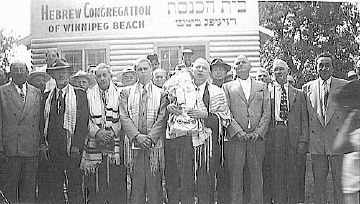Features
One man’s story – Barry Leipsic: choosing to serve his country during World War II

By BERNIE BELLAN Over the years we’ve had many stories in this newspaper chronicling the stories of brave Jewish men and women who served in various armed forces over the years.
It’s one thing to read history books that describe wars, it’s another thing to read personal accounts of what it was like to be in an actual war.
Recently we were contacted by Peter Leipsic, who asked us whether we’d be interested in seeing correspondence from around the time of World War II which tells the story of his own father, Barry’s, experiences, serving with the Fort Garry Horse, a mechanized unit of the Canadian Armed Forces.
Among the artifacts Peter has in his possession are a number of letters written by Barry to his parents, Louis and Nell Leipsic, along with newspaper clippings describing some of the action in which Barry Leipsic was involved.
I note, after having read Peter’s own account of his family history in the Jewish Foundation Book of Life, that his mother, Yvonne, met her future husband in London, England, when Barry Leipsic was stationed there during the war. In Yvonne’s obituary, the story how she happened to meet Lieut. Barry Leipsic is told: “She recalled her blind luck when during the Blitz, due to a local fire, she was forced to spend the night at the hotel. In the morning, she discovered her entire apartment building had been leveled by a direct hit. It was at about this time that she was introduced to Barry Leipsic, a dashingly handsome 25-year old Lieutenant from Winnipeg, stationed in England with the Fort Garry Horse Tank Regiment. Yvonne and Barry were married in 1944. Like so many war brides she immigrated to Canada, to its winters and remoteness; a world even more foreign than anything for which England might have prepared her.”
While Lieut. Leipsic remained in England, Yvonne Leipsic – like many a war bride, came to Canada on her own. According to Peter’s account in the Book of Life, however, his mother, who was born in Vienna, was “accustomed to culture and refined living, and found adjustment to Winnipeg difficult.”
What Peter also told me was that his father was badly wounded during the war. Barry Leipsic lost his left eye, part of his right ear, and was also wounded in his left hand. Yet, according to Peter, his father never dwelled on his war wounds. In fact, he was prone to taking out his glass eye and playing with it – to the amusement of his children and later his grandchildren.
What follows are excerpts from letters, newspaper clippings, and telegrams, that give an insight into the character of Barry Leipsic – someone who grew up in a well-to-do Winnipeg family, yet who joined the Canadian army early on in World War II.
Here is an excerpt written to his mother in September 1939, when she was visiting in New York and Barry was in Winnipeg:
“Dearest Mother…
“You will be happy to know that your son is going to serve his country and the Jews. Yes, I have enlisted in the Fort Garry Horse (mechanized)….I was going to wait until you returned home but after giving it due consideration and thought I decided it would be easier for both of us, doing the good deed while you were absent. It will be a year before we are fully trained and equipped and by that time the war should be over. Please don’t think I enlisted just for the thrill or “getting away from it all” spirit…I do honestly believe that every Jew able to serve should do so at this time. In fact it is going to be very uncomfortable for a good many Jews if a good percentage do not enlist….
“Please wish me luck in my new vocation.”
“All my love to you darling and hurry home”
“Barry”
First enlisted as a corporal, it wasn’t long before Cpl. Leipsic received his first promotion – to sergeant. Here are excerpts from a letter Barry Leipsic wrote to his parents in June 1940, informing them of his promotion, during his training at Camp Shilo:
“Dear Mom, Dad, etal,
“A pleasant and somewhat expected surprise came today. Major Halpenny called myself and another Corporal into the Orderly Room and in a very solemn voice informed us that we were promoted to Lance Sargeants. Financially that means another 25 cents per day, we have the same standing, perform the same duties as sargeants and are addressed as sargeants. However, officially it does not take affect (sic) until tomorrow when it appears on regimental orders, so as to play the safe side better write me still as corporal.
“The reason for the last line is one can never be to (sic) presumptious (sic) in this army and here’s the reason why. It seems quite likely that we will be leaving camp tomorrow, as to our destination, that is yet to be seen but I am positive we will not be leaving Canada, it is even rumored that we might go to a prison camp at Fort Frances or Hudson, Ont. To guard alien prisoners, however that is only a rumor. Just as soon as I have anything definite I will let you know. This afternoon our advance party left, and all stores are being packed, kits inspected for shortages etc and above all the rumors are flying like bats in a haunted house. There is nothing official as yet and I suppose we will only know definitely when we get on the train.
“There is nothing at all to worry about and remember that I will let you know when anything further takes place.
“Until then I am your devoted son.
“Love Barry”
Included with the artifacts Peter Leipsic has in his possession is this amusing bulletin that was posted at Camp Shilo in June 1940:
“ATTENTION ALL YIDS
“A large piece of Versht and two loaves of rye have been received by Bdr. Herb. Ludman, of the 20th Anti-Tank Battery.
“All Yiddlach are cordially invited to have dinner, today, at the 20th Battery Orderly Room tent at 1230 hours today, (8-6-40).
“Let’s see you there!”
“Herb Ludman
“Secty.
“C.C.Y.S.
“Canadian Corps of Yiddish Suckers)”
The Fort Garry Horse was part of the Canadian group that landed at Normandy in June 1944. Members of the Horse fought their way across France, into Belgium, Holland, and finally into Germany.
In a clipping that Peter Leipsic has in his possession, an account written for the Canadian Press on August 2, 1944 describes some of the action encountered by the Fort Garry Horse in an article titled “Garry’s Heavy Barrages Stop Nazi Panther Tanks”:
“LONDON, Aug. 2—(CP Cable)—Two tank experts of the Fort Garry Horse, a Winnipeg regiment, told a press conference here Tuesday how Canadian tanks on the Normandy front are dealing with crack German Panther units.
“Capt. Harry Sleigh of Winnipeg said the Panthers are met by laying down a concentration of high explosive and Canadian tankmen had been highly trained in this type of fire.
“On the Caen front eight days ago, he said, the Fort Garry formation’s supply vehicles got within 200 yards of the tanks and 200 percent of the normal supply of ammunition and fuel were brought up within easy reach in order to keep up the fire.
Lieut. Barry Leipsic, Winnipeg, said German anti-tank weapons were good, particularly their 88-M.M. gun. He described the Canadian attack on Carpiquet airfield July 4 when battleships firing from the sea assisted the artillery barrage and tank-supported infantry to break through.
“Lieut. Leipsic, whose parents, Mr. and Mrs. Louis Leipsic, reside at 186 Dromore ave., joined the F.G.H. in September, 1939. In August, 1942, he graduated from the officers’ training centre at Brockville, Ont. He spent a short time the following November on leave here and then went overseas.”
It was in February 1945 – and by this time Lieut. Leipsic had been promoted to Captain – that Captain Leipsic was badly injured in battle. Yvonne Leipsic was first notified by telegram that her husband had been wounded, soon to be followed by this letter:
“Mrs. Yvonne L. Leipsic…
“Dear Madam,
“Confirming my telegram dated today I regret to inform you that your husband, Capt. Barry Leipsic, has been reported wounded 10 FEB 45.
“No particulars of the nature and extent of his injuries have yet been received, but I can assure you that any further information received here regarding your husband will be communicated to you immediately…
“Yours faithfully,
“(L.S. APPLEFORD) Major”
That letter was subsequently followed by this communication, on March 2, 1945:
“…I am directed to inform you that the following additional information has now been received regarding your husband, Capt. LEIPSIC, Barry, of the 10th. Armd. Regt.
“The diagnosis of your husband’s wounds is as follows: “Gunshot Wound of the Right Ear, the Left Eye and the Left Hand.”
“Yours faithfully,
“(L.S. APPLEFORD) Major”
Capt. Leipsic had been in charge of 19 tanks in Holland at the time he was wounded. He was hit in the head by machine gun fire. The bullet passed through his left eye, coming out his right ear.
Finally, on August 8, 1945, Captain Leipsic, who was now back in Winnipeg, received the following letter:
“Dear Capt. Leipsic:
“I have noted with regret that it is necessary for you to retire from the Canadian Army by reason of wounds sustained in action. Mere words may not seem of much value to you in these circumstances but you should not leave the Army without the assurance I now give you that your sacrifice has not gone unnoticed or unnhonoured.
“In the activities of this Nation I am sure due credit will be paid to those who, like you, carry with them into their civil life visible evidence of the highest patriotism. You are fully entitled to cultivate an inner sense of pride in your achievements and your honourable service in war for your Country’s need and for civilization’s salvation.
“I close with the hope that you may profit by the security and happiness in your civil life which you have done your utmost to earn and do truly deserve.
“(A. E. Walford),
“Major-General,
“Adjutant-General”
Following the war, Barry Leipsic reentered the family business of Aronovitch & Leipsic. He and Yvonne had two children: Peter and Richard. Barry Leipsic died in 1983.
Features
Japanese Straightening/Hair Rebonding at SETS on Corydon

Japanese Straightening is a hair straightening process invented in Japan that has swept America.

Features
History of the Winnipeg Beach Synagogue: 1950-2025

By BERNIE BELLAN The history of the Winnipeg Beach Synagogue is a fascinating one. We have had several articles over the years about the synagogue in The Jewish Post & News.


In June 2010 I wrote an article for The Jewish Post & News upon the 60th anniversary of the synagogue’s opening. Here are the opening paragraphs from that article:
“Sixty years ago a group of Winnipeg Beach vacationers decided that what their vacation area lacked was a synagogue. As it happened, a log cabin one-room schoolhouse in the Beausejour area happened to be available.
“In due course, the log cabin was relocated to the corner of Hazel and Grove in Winnipeg Beach, where it stayed for 48 years.”

In December 1994 my late brother, Matt, wrote a story about the spraying of antisemitic grafitti on the synagogue which, at that time, was still situated at its original location on the corner of Hazel and Grove in the town of Winnipeg Beach:
“Two 16-year-olds spraypainted slogans like ‘Die Jews,’ ‘I’ll kill you Jews,’ and other grafitti in big letters on the beach synagogue.
“Jim Mosher, a news reporter for the Interlake Spectator in Gimli, said last Halloween’s vandalism against the synagogue wasn’t the first. In the late 1980s, he claimed, it was spraypainted with swastikas.
“Jack Markson, a longtime member of the Winnipeg Beach Synagogue, last week also said he could remember finding anti-Semitic grafitti spraypainted on the synagogue ‘a few years ago,’ and at least twice in the 1970s, when the cottage season was over.”

My 2010 article continued: “In 1998 the Town of Winnipeg Beach informed the members of the synagogue that the building would have to be hooked up to the town’s sewer and water system. Rather than incur the cost of $3-4,000, which was thought to be ‘prohibitive,’ according to longtime beach synagogue attendee Laurie Mainster, synagogue goers looked elsewhere for a solution.
“As a result, the board of Camp Massad was approached and asked whether the synagogue might be relocated there, with the understanding that the synagogue would be made available to the camp at any time other than what were then Friday evening and Saturday morning services.
“Over the years the ‘beach synagogue’ had come to be a very popular meeting place for summertime residents of Winnipeg Beach and Gimli. In fact, for years minyans were held twice daily, in addition to regular Saturday morning services. Of course, in those years Winnipeg Beach was also home to a kosher butcher shop.
“While the little synagogue, which measured only 18 x 24 feet, has gone through several transformations, including the move to Camp Massad, and the opening up to egalitarian services in 2007 (The move to egalitarian services was as much a practical necessity as it was a nod to the equality of women – the only Kohen present at the time was a woman!), it has always remained cramped at the best of times.

“In recent years the synagogue has seen the addition of a window airconditioner (although to benefit from it, you really have to be sitting just a few feet away), as well as a fridge that allows synagogue attendees to enjoy a regular Saturday morning Kiddush meal following the service.
“According to Laurie Mainster, the Saturday morning service has continued to be popular, even though many of the attendees now drive in from Winnipeg, as they have sold the cottages they once maintained.
“On the other hand, one of the side benefits to being located on Camp Massad’s grounds has been an infusion of young blood from among the camp counsellors.
“Since there is no longer a rabbi available to conduct services (Rabbi Weizman did lead services for years while he had a cottage at the beach), those in attendance now take turns leading the services themselves.
“Anyone may attend services and, while there are no dues collected, donations are welcome. (Donations should be made to the Jewish Foundation of Manitoba, with donors asked to specify that their donations are to be directed to the beach synagogue.)
“Mainster also says that the beach synagogue is now undergoing an expansion, which will be its first in 60 years. An entirely new space measuring 16 x 18 feet is being added – one that will allow for a real Kiddush area. (Until now, a table has been set up in the back of the synagogue and synagogue goers would help themselves to the buffet that is set up each Saturday during the summer. While pleasant enough, it will certainly be more comfortable to have an actual area set aside for the Saturday afternoon after service lunch.)
“As for dress, longtime attendee Abe Borzykowski (in an article written by Sharon Chisvin for the Free Press in 2007) remarked that ‘I don’t think there are many synagogues where people can attend in shorts, T-shirts and sandals and not feel out of place.’ “

As mentioned in that 2010 article, the beach synagogue at that time was about to undergo an extensive remodelling. Here is an article from a January 2011 issue that describes that remodelling process. The article was written by Bernie Sucharov, who has been a longtime member of the beach synagogue:
“The Hebrew Congregation of Winnipeg Beach made a major change to the synagogue this past summer. With the help of many volunteers, Joel Margolese being the project manager, the synagogue was expanded and an addition was built to handle the overflow crowds, as well as to add more space for the kiddush following services.
“The volunteers spent many Sundays during the summer months building the addition. Bad weather caused many delays, but finally the addition was completed one week before the official summer opening.
“The volunteers were: Joel Margolese, Gordon Steindel, Sheldon Koslovsky, Viktor Lewin, Harvey Zabenskie, Nestor Wowryk, Kevin Wowryk, Victor Spigelman, Jerry Pritchard, and David Bloomfield.
“On Sunday, June 25, 2010 a special ceremony was held to affix a mezzuzah to the front entrance door. Gordon Steindel had the honour of affixing the mezzuzah, which was donated by Sid Bercovich and Clarice Silver.
“Refreshments and food for the day were prepared by Phyllis Spigelman, also known as our catering manager. Throughout the summer, Phyllis, Lenore Kagan and other friends prepared the food for our kiddush.
“A sound system was donated by Arch and Brenda Honigman in memory of their father, Sam Honigman z”l. “The system was installed by Joel Margolese and Stevan Sucharov. This will allow the overflow crowd to hear the service in the new addition.
“There were also generous donations of 50 chumashim and an air conditioner. The chumashim were donated by Gwen, Sheldon and Mark Koslovsky. The air conditioner in the new addition was donated by Joel and Linda Margolese.
“The official opening of the synagogue for the summer took place on July 3, 2010. We had an overflow crowd of 70+ people.”

Since that 2010 major addition to the synagogue, it has also added a wheelchair ramp (although I’ve been unable to ascertain exactly when the ramp was built). Also, the synagogue also has its own outdoor privy now. (Attendees used to have to use facilities in Camp Massad.)
And, as already noted in article previously posted to this site (and which you can read at Beach Synagogue about to celebrate 75th anniversary), in recognition of that occasion, on August 2nd members of the synagogue will be holding a 75th anniversary celebration.
As part of the celebration anyone who is a descendant or relative of any of the original members of the first executive committee is invited to attend the synagogue that morning.
If you are a relative please contact Abe Borzykowski at wpgbeachshule@shaw.ca or aborzykowski@shaw.ca to let Abe know you might be attending.
Features
Kinzey Posen: CBC Winnipeg’s former “go-to guy”

By GERRY POSNER If former Winnipegger Lawrence Wall was the CBC go-to guy in Ottawa, CBC Winnipeg had its own version of a go-to guy for many years with none other than the very well known Kinzey Posen. Of course, many readers will recognize that name from his career with Finjan, the Klezmer group so famous across Canada and beyond. It has been written about Posen and his wife Shayla Fink that they have been involved in music since they got out of diapers. And, as an aside, their love and ability in music has now been transmitted to the next generation as in their son, Ariel Posen (but that’s another story).
Kinzey Posen (not to be confused with Posner, or maybe we are to be confused, but who knows for sure?), was a graduate of Peretz School, having attended there from nursery right until Grade 7, graduating in1966. That was followed by Edmund Partridge and West Kildonan Collegiate. Musically, he was in large part self taught. However, he did have some teachers along the way. After moving to Vancouver – from 1974-78, he had the chance to study acoustic classical bass with a member of the Vancouver Symphony Orchestra. When Kinzey lived in Vancouver, he also worked as a jazz musician.
Upon returning to Winnipeg, Kinzey enrolled as a mature student at the University of Winnipeg, where he obtained a Bachelor of Urban Studies degree. Although the degree was in no way connected to the career that followed, his attending the University of Winnipeg was critical to his connecting with the CBC. Why? you ask. Kinzey had a position after graduation working for the Institute of Urban Studies. While there, he met someone who invited him to work for the Department of Continuing Education as one of their program directors. At the time the Department of Continuing Education was located at 491 Portage Avenue, which was also known as the TJ Rice Building. The CBC also leased some space in the same building. According to Kinzey, the CBC part of the building “included HR, different shows and other support offices. Continuing Education was located in the basement and main floor and that’s where I worked.”
KInzey had long had an interest in the CBC, which made the fact that the CBC had some offices in the same building where he was working serendipitous. That Kinzey might be interested in visiting the CBC was not an accident. As a young boy he had a nightly connection to CBC, as it was his ritual to listen to CBC Radio (as well as all sorts of other radio stations across the USA) on his transistor radio every night in bed. He became enamoured of one particular CBC host, Bill Guest, so that when going to sleep, he imagined that he was Guest doing interviews with imaginary guests. That dream of working for CBC became a reality when he had a chance to do a one week gig with Jack Farr’s network program.
Kinzey took a week off from his Continuing Education job and spent five days at the CBC. That week was a training session for Posen, as he had to create ideas, research, pre-interview, write the script, and set up the studio for Farr’s interview. He was almost in his dream job – although not quite – since it was only for one week. His opportunity, however, came in 1988, when he was offered a one-year term as a production assistant – the lowest guy on the ladder, for a show called “ Simply Folk,” with the late Mitch Podolak as the host. Although he was indeed at the bottom as far as those working on the show were concerned, he took a chance and gave his notice to the U of W. The rest is history. In his new job, Kinzey learned how to become a producer. Lucky for him, at the end of the year, when the person he replaced was supposed to come back, she never returned (just like the song, “MTA,” by the Kingston Trio). At that point, Kinzey was hired full time at the CBC.
Kinzey was a fixture at the CBC for 27 years. During those years, Kinzey had the chance to work with Ross Porter, a respected former CBC host and producer, also with Karen Sanders – on the “Afternoon Edition.” One aspect of Kinzey’s job on the Afternoon Edition was to come up with ideas, mix sound effects, arrange interviews and music, to create a two-hour radio experience. In addition, he covered jazz and folk festivals and, as a result, was exposed to some of the best musicians in the world. With Ross Porter in the 1990s, he worked on a network jazz show called “ After Hours,” which was on from 8-10 PM five nights a week. Kinzey was involved with writing the scripts, picking the music, and recording the shows, as well as editing them and then presenting them to the network for playback.
Of course, over his career, Kinzey had many memorable moments. He told me about one of them. The story revolved around the National Jazz Awards one year in particular. The awards were to be broadcasted after the National News which, in those days, began much earlier in the evening, and were over by 8:00 pm. The legendary Oscar Peterson was lined up to play a half hour set at the awards, starting at 7:30. But, as Kinzey told me, Oscar Peterson had a “hate on” for the CBC ecause one of his recorded performances was wrongly edited and he refused to appear on CBC under any circumstances. As the time neared 8:05 PM, which was when the CBC was to begin its broadcast of the jazz awards, it became apparent that Oscar was not going to finish on time. As the producer of the awards show, Kinzey was tasked with telling Oscar Peterson to wrap it up and get off the stage. There was Kinzey Posen, a huge fan of Oscar Peterson, now faced with the prospect of telling Oscar – while he was still playing – with 500 people in the audience, to stop and get off the stage. Not often was or is Kinzey Posen frozen, but that was one such moment. There was one loud “Baruch Hashem” from Kinzey when Oscar completed his set literally just in time.
Clearly, Kinzey was part of a very successful run with After Hours as it was on the air for 14 years. It was easily one of the most popular shows on CBC Radio 2, and a winner of several broadcasting awards. Kinzey also played a major role in producing a two part documentary about legendary guitarist Lenny Breau.
When After Hours ended, Posen became one of the contributing producers to Canada Live and specialized in producing live radio specials for the network, such as the Junos, for CBC Radio One and Two. Needless to say, his career planted Posen in the world of some top notch musicians, including his time spent working with Robert Plant (Led Zeppelin), Dave Brubeck, Randy Bachman, Chantal Kreviazuk and a list of prominent names in the Canadian, American and European music spheres. Locally, the CBC came to refer to Kinzey as the Jewish expert. I would add music expert to that title.
After his 27 year run at the CBC – and before he fully retired, Kinzey went on to work for the Rady JCC as a program director for a year and a half. Of course, to say that Kinzey Posen is retired is a major contradiction in terms. You really can’t keep him down and he has his hand in a variety of programs and projects – most of which he remains silent about, as is his style.
When I realized the full depth and talent of Kinzey Posen, I quickly concluded that he must certainly be related to me. Even if he isn’t, I now tell people he is.
